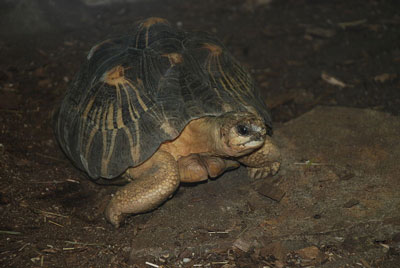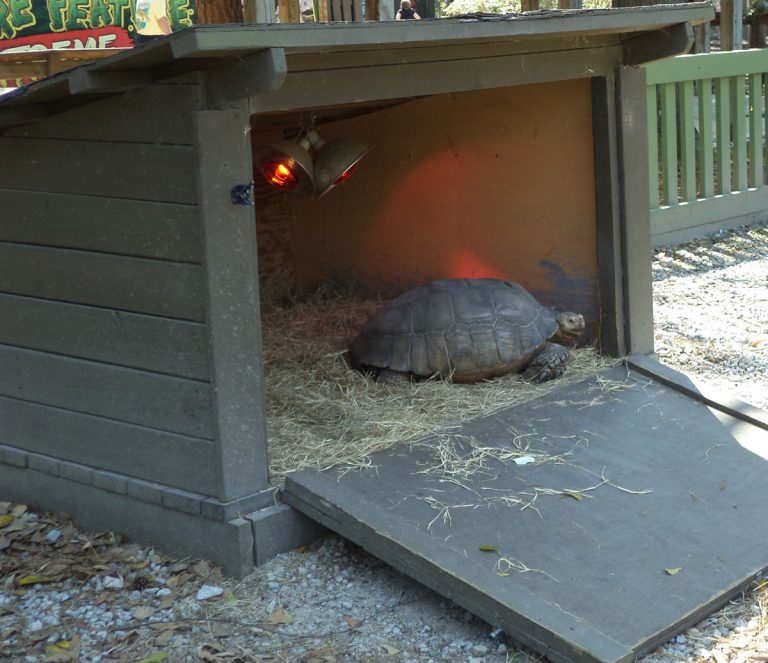Radiated Tortoise
Scientific Classification
| Kingdom: | Animalia |
| Phylum: | Chordata |
| Class: | Sauropsida |
| Order: | Testudines |
| Suborder: | Cryptodira |
| Family: | Testudinidae |
| Genus: | Astrochelys |
| Species: | A. radiate |
| Binomial name: | Astrochelys radiate |
One can only rarely see a radiated tortoise Astrochelys Radiate belonging to the endangered species, but they are very good pets. They belong to the family Testudinidae and are usually of reasonable size, and enjoy long lives. The easiest method to spot the turtles is by their ornamental shells, even though you might occasionally confuse them with the tiny star tortoises.

Anatomy

The radiated tortoise usually has a carapace with a high dome, of maximum length 16 inches or 41 cm. They weigh about 35 lbs (16kg). They are popular across the globe for their beauty, and even though their average life is usually 40-50 years, some live up to 200 years. The blunt head, elephantine feet as well as the legs are yellow in color. A few varieties tend to have a black patch on the top of their heads.
They have a bright ornamental carapace is with yellow bands, generating from the midpoint of the dark colored shell plate and this is the reason, why they call them radiated tortoise. The star shaped decoration, is more prominently defined than the other varieties of star patterned tortoises.
Behavior
The radiated tortoise usually prefers to lead a remote life, even though you may seldom see them feeding or resting together, especially during the breeding season. These tortoises have the capability to adjust themselves to the varying seasons (from arid weather to heavy rainfall). They say that you can find them dancing in the rain. They emit a booming noise to scare off their predators.
Habitat
Only the Southwestern and extreme Southern regions of the Madagascar Islands are ideal habitats for these Radiated tortoises. Someone has introduced them to Reunion, an Island nearby.
These animals excel in the woodlands, thorn forests (Diderae) and the dry thorn brush regions of the Southern part of Madagascar.
As a Pet

Breeding
The radiated tortoise generally mates as soon as they grow, about half of the size attained by a matured adult. The males bob their head, vertically, towards the female. After mating, the females dig the nest, in the field, laying about 5 eggs. They can lay maximum 10 lays. The incubation period lasts for 4-7 months, and then the young hatchlings come out, with a length of 3-4cm.
Housing
The radiating tortoise comes from the hot and humid climate of the southern part of Madagascar. If you keep them at home, the room must be warm and comfortable enough, providing them ample space to walk and move. Usually, a matured tortoise requires minimum eight by four foot space, and hence many of the tortoise owners, create a room outside their house to keep the pets. Other owners, use special tables for turtles, with borders and barriers to prevent the pets from climbing out and some keep huge plastic storage containers instead of the valuable fish tanks.
If you are planning to keep your pet outside your house, make sure that the temperature is about 60 degrees Fahrenheit, as it is very crucial to allow ample sunlight for the tortoises to live comfortably during the warm months. You should provide heat, lighting, as well as a cool zone for them to relax. Abundant amount of water and mud must be supplied, so that they can roll around. Cypress mulch is ideal to offer perfect bedding as it can retain natural water. However, one must rake care that they do not ingest it for it can have an adverse effect.
It is needless to say that the room must be safe and secure from wild animals. In order to prevent raccoons or birds from disturbing the tortoises, one may put up screens with borders caved in, so that no animals can burrow through the pen.
Food
Being herbivorous, you must supply the radiated tortoises with fresh vegetables, green grasses, cactus leaves (without spines) and the like. Do not feed them flesh or other items rich in protein. Orchard grass, alfalfa, Timothy hay, fescue, Bermuda grass or rye grass are common food items. Kale, escarole, mustard greens, parsley and all other fresh greens having a decent proportion of calcium-phosphorous ratio can serve the purpose as well. Otherwise, your pet might become a choosy eater.
Supplying abundant calcium inside the body is very vital, and thus you must sprinkle calcium powder to dust the veggies often. You can also give them a little quantity of fruits. Keep in mind, that the radiated tortoises have an affinity for reddish colored fruits.
Handling

As mentioned earlier, the radiated tortoises are very beautiful and attractive, look-wise as well as personality-wise. Since they are solitary in nature, and not very extrovert, they seek special attention from the keepers.

Having discovered a fondness for insects while pursuing her degree in Biology, Randi Jones was quite bugged to know that people usually dismissed these little creatures as “creepy-crawlies”.







